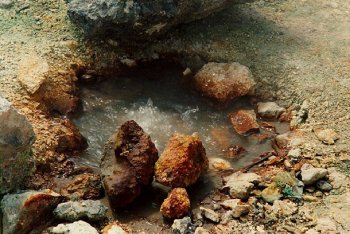hyperthermophiles

Red coloration on rocks near Naples, Italy, produced by the hyperthermophile Sulfolobus solfataricus.
Hyperthermophiles are microbes that reproduce and grow at very high temperatures, in the range 60 to 113°C (140 to 235°F). The first to be identified, Sulfolobus acidocaldarius, which is both a hyperthermophile and an acidophile, was found in the late 1960s in a hot, acidic spring in Yellowstone National Park, Wyoming. Since then, more than 50 hyperthermophiles have been isolated. The majority are archaea, although some cyanobacteria and anaerobic photosynthetic bacteria grow well at 70 to 75°C (158 to 167°F). The most heat-resistant of all known hyperthermophiles are the anaerobic archaea, including members of the genuses Pyrolobus, Pyrodictium, and Pyrococcus. For example, Pyrolobus fumarii, of the Crenarchaeota, a nitrate-reducing chemolithotroph (an organism that derives energy from minerals), grows on the walls of marine hydrothermal vents ("smokers"). It multiplies best at about 105°C (221°F), can reproduce at up to 113°C (235°F) and stops growing in "cooler" environments below 90°C (194°F). Another hyperthermophile that lives in deep-sea vents, Methanopyrus, is of special interest because of its ancient genetic make-up. Analysis of its genes suggests that it may have been among the earliest organisms on Earth. Further study of it may help shed light on how the first cells survived (see life, origin of).
The upper temperature limit of terrestrial life has yet to be determined. But, although the search is on for "super-hyperthermophiles", it would be surprising to find microbes thriving at 150°C (302°F) or more. At this temperature, current understanding suggests that no biological strategy could prevent the breakdown of chemical bonds that hold DNA and other vital molecules together.


